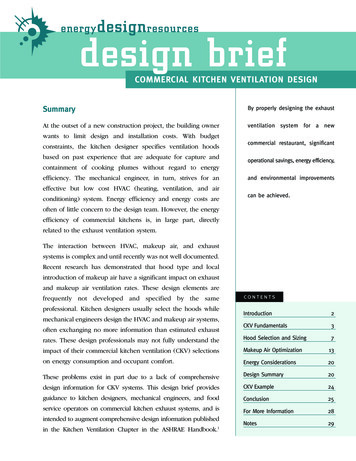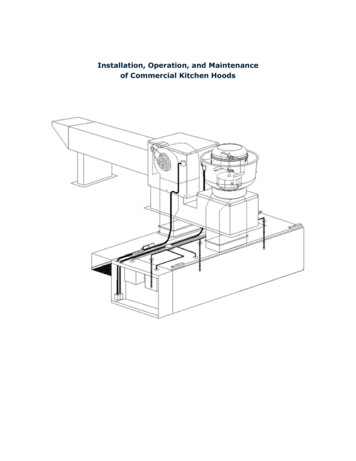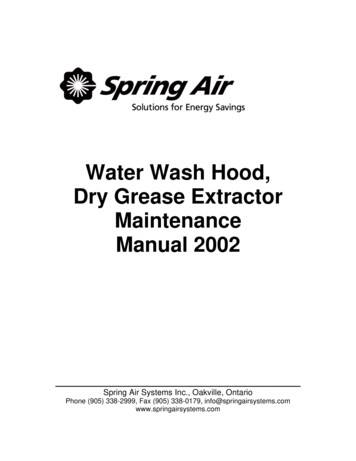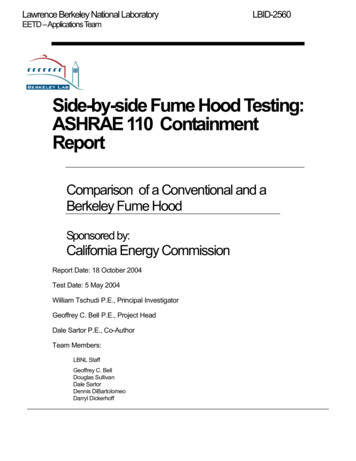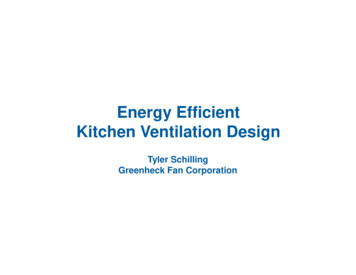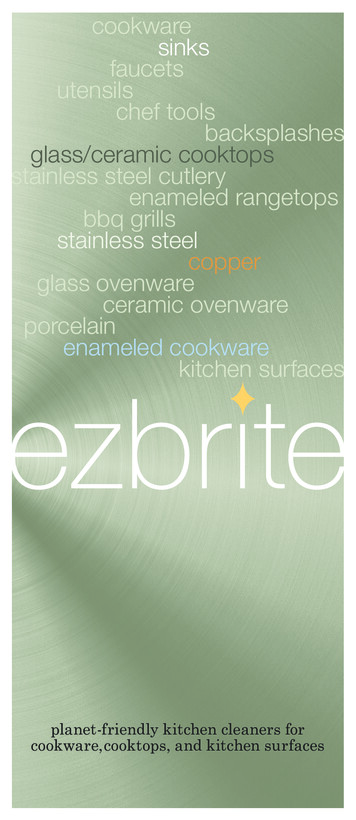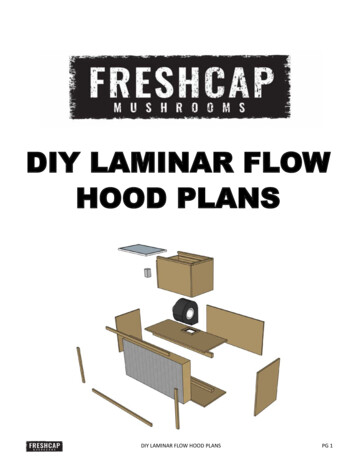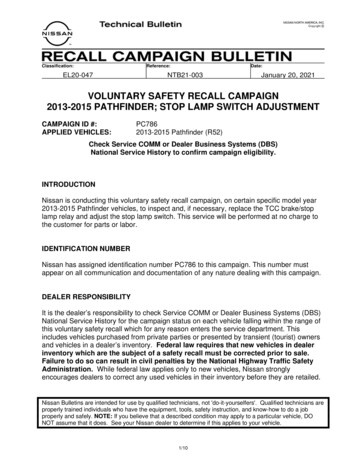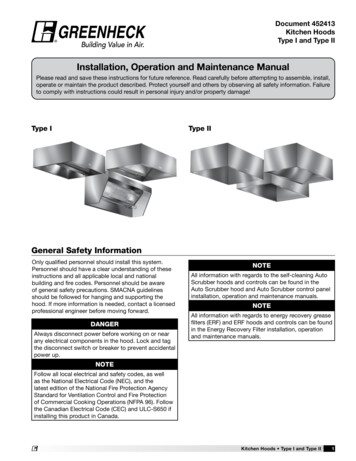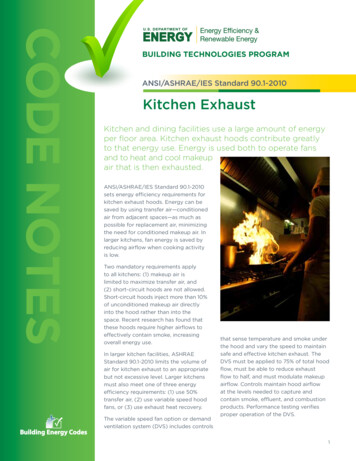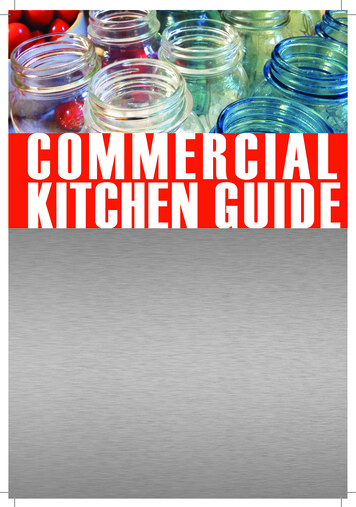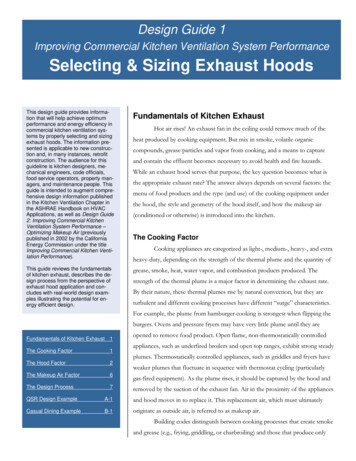
Transcription
The Design ProcessDesign Guide 1Improving Commercial Kitchen Ventilation System PerformanceSelecting & Sizing Exhaust HoodsThis design guide provides information that will help achieve optimumperformance and energy efficiency incommercial kitchen ventilation systems by properly selecting and sizingexhaust hoods. The information presented is applicable to new construction and, in many instances, retrofitconstruction. The audience for thisguideline is kitchen designers, mechanical engineers, code officials,food service operators, property managers, and maintenance people. Thisguide is intended to augment comprehensive design information publishedin the Kitchen Ventilation Chapter inthe ASHRAE Handbook on HVACApplications, as well as Design Guide2: Improving Commercial KitchenVentilation System Performance –Optimizing Makeup Air (previouslypublished in 2002 by the CaliforniaEnergy Commission under the titleImproving Commercial Kitchen Ventilation Performance).This guide reviews the fundamentalsof kitchen exhaust, describes the design process from the perspective ofexhaust hood application and concludes with real-world design examples illustrating the potential for energy efficient design.Fundamentals of Kitchen ExhaustHot air rises! An exhaust fan in the ceiling could remove much of theheat produced by cooking equipment. But mix in smoke, volatile organiccompounds, grease particles and vapor from cooking, and a means to captureand contain the effluent becomes necessary to avoid health and fire hazards.While an exhaust hood serves that purpose, the key question becomes: what isthe appropriate exhaust rate? The answer always depends on several factors: themenu of food products and the type (and use) of the cooking equipment underthe hood, the style and geometry of the hood itself, and how the makeup air(conditioned or otherwise) is introduced into the kitchen.The Cooking FactorCooking appliances are categorized as light-, medium-, heavy-, and extraheavy-duty, depending on the strength of the thermal plume and the quantity ofgrease, smoke, heat, water vapor, and combustion products produced. Thestrength of the thermal plume is a major factor in determining the exhaust rate.By their nature, these thermal plumes rise by natural convection, but they areturbulent and different cooking processes have different “surge” characteristics.For example, the plume from hamburger cooking is strongest when flipping theburgers. Ovens and pressure fryers may have very little plume until they areFundamentals of Kitchen Exhaust 1opened to remove food product. Open flame, non-thermostatically controlledappliances, such as underfired broilers and open top ranges, exhibit strong steadyThe Cooking Factor1The Hood Factor2The Makeup Air Factor6gas-fired equipment). As the plume rises, it should be captured by the hood andThe Design Process7removed by the suction of the exhaust fan. Air in the proximity of the appliancesplumes. Thermostatically controlled appliances, such as griddles and fryers haveweaker plumes that fluctuate in sequence with thermostat cycling (particularlyQSR Design ExampleA-1and hood moves in to replace it. This replacement air, which must ultimatelyCasual Dining ExampleB-1originate as outside air, is referred to as makeup air.Building codes distinguish between cooking processes that create smokeand grease (e.g., frying, griddling, or charbroiling) and those that produce only
Fundamentals of Kitchen ExhaustBuilding CodesHistorically the United States had threeorganizations that drafted model buildingcodes which were adopted by local jurisdictions as law. These organizationssponsored development of standardizedbuilding codes, usually called “modelbuilding codes”, to assure better codeuniformity within the three regions inwhich they evolved. In the northeast US,the Building Officials Council Associationsponsored the National Building Code.In the southeast US, the Southern Building Code Council International, sponsored the Standard Building Code. Inwestern US, the International Council ofBuilding Code Officials sponsored theUniform Building Code. California jurisdictions adopted the UBC, including theUniform Mechanical Code (UMC).In 1994 these organizations formed theInternational Code Council to unify theircodes. In 2000, the first full edition of theInternational Building Code (IBC) waspublished.In 2000, the National Fire ProtectionAssociation (NFPA) announced that itwould sponsor a complete building codethat would be an alternative to the IBC.In 2002, NFPA published its first edition.heat and moisture (e.g., dishwashing and some baking and steaming operations).Cooking that produces smoke and grease requires liquid-tight construction witha built-in fire suppression system (Type I hood), while operations that produceonly heat and moisture do not require liquid-tight construction or a fire suppression system (Type II hood).Menu items may produce more or less smoke and grease depending ontheir fat content and how they are cooked. Higher fat content foods tend to release more smoke and grease regardless of the type of cooking process. Testingunder an ASHRAE sponsored research project at the University of Minnesotaconfirmed that hamburger cooked on a charbroiler releases finer smoke particles and more grease vapor and particles than hamburger cooked on a griddle.The percentage fat content of hamburger also contributes to differences in theamount of grease and smoke released in cooking. Chicken breast, which hasless fat compared to hamburger, releases less particulate and less grease duringcooking on a charbroiler or on a griddle compared to hamburger.The Hood FactorThe design exhaust rate also depends on the hood style and construction features. Wall-mounted canopy hoods, island (single or double) canopyMechanical code requirements forkitchen ventilation are similar amongthese model codes.hoods, and proximity (backshelf, pass-over, or eyebrow) hoods all have differ-Unlisted Hoods must meet the prescriptive materials and design requirementsof the local building and health codes. Inaddition they must be operated at exhaust rates dictated by the local buildingcode.relative to the cooking equipment (see Figure 1). Generally, for the identicalListed Hoods have been tested againsta recognized standard, such as Underwriters Laboratories (UL) Standard 710.Standard 710 dictates materials anddesign requirements similar to those inthe building code and it has a performance test requirement for capture andcontainment of the thermal plume.island canopy tends to emulate the performance of two back-to-back wall-ent capture areas and are mounted at different heights and horizontal positions(thermal plume) challenge, a single-island canopy hood requires more exhaustthan a wall-mounted canopy hood, and a wall-mounted canopy hood requiresmore exhaust than a proximity (backshelf) hood. The performance of a doublecanopy hoods, although the lack of a physical barrier between the two hoodsections makes the configuration more susceptible to cross drafts.Building codes also require Type Ihoods (liquid-tight construction with abuilt-in fire suppression system) overcooking operations which producesmoke and grease. requires Cookingoperations that produce only heat andmoisture require a Type II hood (liquidtight construction and a fire suppressionsystem are not required).Design Guide 1 – Selecting and Sizing Exhaust Hoods – 03.15.042
Fundamentals of Kitchen ExhaustWall Mounted CanopySingle Island CanopyDouble Island CanopyEyebrowBack ShelfPass OverFigure 1. Styles of Exhaust Hoods.A note of caution: Although a well-engineered proximity hood can beapplied with success at very low exhaust rates (e.g., 150 cfm per linear foot overmedium-duty equipment), this same style of hood (if specified without performance data and/or in accordance with maximum height and setback permitted by code) may fail to effectively capture and contain the cooking effluent atexhaust rates of 300 cfm/ft or more. Figure 2 illustrates relatively effective andineffective applications of proximity hoods.Design Guide 1 – Selecting and Sizing Exhaust Hoods – 03.15.043
Fundamentals of Kitchen ExhaustFigure 2. Proximity HoodEffective DesignIneffective DesignBuilding and/or health codes typically provide basic construction andmaterials requirements for exhaust hoods, as well as prescriptive exhaust ratesbased on appliance duty and length of the hood (cfm per linear ft.) or open facearea of the hood (cfm per ft2). Codes usually recognize exceptions for hoodsthat have been tested against a recognized standard, such as Underwriters Laboratories (UL) Standard 710. Part of the UL standard is a “cooking smoke andflair up” test. This test is essentially a cooking effluent capture and containment(C&C) test where “no evidence of smoke or flame escaping outside the exhausthood” must be observed. Hoods bearing a recognized laboratory mark arecalled listed hoods, while those constructed to the prescriptive requirements ofthe building code are called unlisted hoods. Generally, an off-the-shelf listed hoodcan be operated at a lower exhaust rate than an unlisted hood of comparable styleand size over the same cook line. Lower exhaust rates may be proven by laboratory testing with specific hood(s) and appliance lineup using the test protocoldescribed in ASTM Standard F-1704, Test Method for Performance of CommercialKitchen Ventilation Systems. This process is sometimes referred to as “customengineering” a hood.Laboratory testing of different combinations of appliances has demonstrated that minimum capture and containment rates vary significantly due toappliance type and position under the hood. For example a heavy-duty appliance at the end of a hood is more prone to spillage than the same appliance located in the middle of the hood.Design Guide 1 – Selecting and Sizing Exhaust Hoods – 03.15.044
Fundamentals of Kitchen ExhaustSide Panels and OverhangSide (or end) panels (as represented in Figure 3) permit a reduced exhaust rate in most cases, as all of the replacement air is drawn across the frontof the equipment, which improves containment of the effluent plume generatedby the hot equipment. They are a relatively inexpensive way to improve C&Cand reduce the total exhaust rate. Another benefit of end panels is to mitigatethe negative effect that cross drafts can have on hood performance. It is important to know that partial side panels can provide almost the same benefit as fullpanels. Although tending to defy its definition as an “island” canopy, end panelscan improve the performance of a double-island or single-island canopy hood.An increase in overhang should improve the ability of a canopy hoodto capture because of the increased distance between the plume and hoodedges. This may be accomplished by pushing the appliances as far back under acanopy hood as practical and/or by increasing the side length. Although thisimproves C&C performance, for unlisted hoods under a local jurisdiction referencing the Uniform Mechanical Code (UMC), this would require increase in thecode-required exhaust rate. Larger overhangs are recommended for appliancesthat create plume surges, such as convection and combination ovens, steamersand pressure fryers. This was the driving argument for converting the codeFigure 3. Illustration ofpartial and full sidepanels.specified exhaust rates from a “cfm/ft2” to a “cfm/linear ft.” basis in the current edition of the International Mechanical Code (IMC).Hood GeometryThe ability of a hood to capture and contain cooking effluent can oftenbe enhanced by adding passive features (e.g., angles, flanges, or geometric flowdeflectors) or active features (e.g., low-flow, high-velocity jets) along the edgesof the hood or within the hood reservoir. Such design features can improvehood performance dramatically over a basic box-style hood with the samenominal dimensions.Cross DraftsCross drafts can have a detrimental affect on all hood/appliance combinations. Cross-drafts affect island canopy hoods more than wall mountedcanopy hoods because they have more open area allowing drafts to push or pulleffluent from the hood. For example, a pedestal fan used by staff for additionalcooling can severely degrade hood performance, may make capture impossible,Design Guide 1 – Selecting and Sizing Exhaust Hoods – 03.15.045
Fundamentals of Kitchen Exhaustand may spill the plume into the kitchen. Location of delivery doors, servicedoors, pass-through openings and drive-through windows may be sources ofcross drafts due to external and internal air pressure differences. Cross draftscan also be developed when the makeup air system is not working correctly,causing air to be pulled from open drive-through windows or doors.The Makeup FactorThe layout of the heating, ventilating, and air-conditioning (HVAC) andmakeup air (MUA) supply air outlets or diffusers can affect hood performance.These can be sources that disrupt thermal plumes and hinder C&C. Safety factors are typically applied to the design exhaust rate to compensate for the effectthat undesired air movement within the kitchen has on hood performance.Air that is removed from the kitchen through an exhaust hood must bereplaced with an equal volume of outside replacement (makeup) air through oneor more of the following pathways:1. Transfer air (e.g., from the dining room)2. Displacement diffusers (floor or wall mounted)3. Ceiling diffusers with louvers (2-way, 3-way, 4-way)4. Slot diffusers (ceiling)5. Ceiling diffusers with perforated face6. Integrated hood plenum including (see Figure 4): Short circuit (internal supply) Air curtain supply Front face supply Perforated perimeter supply Backwall supply (rear discharge) Combinations of the aboveDesign issues related to replacement (makeup) air and its impact onhood performance are the subject of Design Guide 2, Improving CommercialKitchen Ventilation Performance – Optimizing Makeup Air (previously published bythe California Energy Commission under the title Improving Commercial KitchenVentilation Performance).Figure 4. Types of MUASupply Integrated with theHood.Design Guide 1 – Selecting and Sizing Exhaust Hoods – 03.15.046
The Design ProcessSuccessfully applying the fundamentals of commercial kitchen ventilation (CKV) during the design process requires a good understanding of the localbuilding code requirements, the menu and appliance preferences, and the project’s budget. Information about the kitchen equipment and ventilation requirements may evolve over the course of the design phase. Data needed byother members of the design team may require early estimates of certain parameters (e.g., the amount of exhaust and makeup air, motor horsepower, watersupply and wastewater flow rates). As more decisions are made, new information may allow (or require) refinements to the design that affect exhaust andmakeup air requirements.The fundamental steps in the design of a CKV system are:1. Establish location and “duty” classifications of appliances includingmenu effects. Determine (or coordinate with foodservice consultant) preferred appliance layout for optimum exhaust ventilation.2. Select hood type, style, and features.3. Size exhaust airflow rate.4. Select makeup air strategy; size airflow and layout diffusers.Steps 1 through 3 are discussed in this Design Guide; Step 4 is the subject ofDesign Guide 2, Improving Commercial Kitchen Ventilation Performance – OptimizingMakeup Air.A good understanding of how building code requirements apply tokitchen design is essential. Local or state building codes are usually based onone of the “model” building codes promulgated by national code organizations(see sidebar). Our discussion of the building codes will be limited to requirements that affect design exhaust and makeup air rates, which are usually foundin the mechanical code portion of the overall building code.Historically, codes and test standards used “temperature” ratings forclassifying cooking equipment. Although these temperature ratings roughly correlated with the ventilation requirement of the appliances, there were many grayareas. During development of ASHRAE Standard 154, Ventilation for Commercial Cooking Appliances, it was recognized that plume strength, which takesinto account plume volume and surge characteristics, as well as plume temperature, would be a better measure for rating appliances for application in buildingcodes. “Duty” ratings were created for the majority of commercial cooking appliances under Standard 154, and these were recently adopted by the Interna-Design Guide 1 – Selecting and Sizing Exhaust Hoods – 03.15.047
The Design ProcessAppliance Duty ClassificationsFrom ASHRAE Standard 154Light Duty Gas and electric ovens (includingstandard, bake, roasting, revolving,retherm, convection, combinationconvection/steamer, conveyor,deck or deck-style pizza, and pastry) Electric and gas steam-jacketedkettles Electric and gas compartmentsteamers (both pressure and atmospheric) Electric and gas cheesemelters Electric and gas rethermalizersMedium Duty Electric discrete element ranges(with or without oven) Electric and gas hot-top ranges Electric and gas griddles Electric and gas double-sided griddles Electric and gas fryers (includingopen deep-fat fryers, donut fryers,kettle fryers, and pressure fryers) Electric and gas pasta cookers Electric and gas conveyor (pizza)ovens Electric and gas tilting skillets/braising pans Electric and gas rotisseriestional Mechanical Code (IMC). The Kitchen Ventilation chapter of theASHRAE Applications Handbook (2003 edition) applied the same concept toestablish ranges of exhaust rates for listed hoods. The appended Design Examples in this Guide reference duty classifications for appliances. The duty classifications listed in the sidebar are from ASHRAE Standard 154-2003, Ventilationfor Commercial Cooking Operations.The IMC dictates exhaust rates based on hood type and appliance duty.Table 1 states these exhaust rates in “cfm per linear foot of hood” (“linear foot”in this case applies to the distance from edge to edge along the front face of thehood). The Code requires that the exhaust rate for the highest duty-rated appliance be applied to the entire hood. The Uniform Mechanical Code (UMC), usedin many California jurisdictions, requires calculating exhaust rates based onsquare-footage of capture area (capture area is the open area defined by thelower edges of the hood). The UMC uses temperature classifications for appliances, as described above. Both the IMC and the UMC require a minimum 6inch hood overhang (front and sides) for canopy style hoods.Table 1. Unlisted Hood Exhaust Flow Rates.Heavy Duty Electric and gas underfired broilers Electric and gas chain (conveyor)broilers Gas open-burner ranges (with orwithout oven) Electric and gas wok ranges Electric and gas overfired (upright)broilers SalamandersExtra Heavy DutyAppliances using solid fuel such aswood, charcoal, briquettes, and mesquite to provide all or part of the heatsource for cooking.Calculation of Exhaust Rates Using Duty RatingsThe rule for unlisted hoods is toapply the duty rating for the highestduty appliance to the length of theentire hood (or separate section ofhood served by an individual exhaust fan).For listed hoods, the same rule maybe applied if little is known aboutthe expected cooking operations. Ifdetails of the cooking operation areknown, rates for each appliancemay be applied and added up todetermine the total exhaust rate.IMC Minimum Exhaust Flow Rate for Unlisted Hoods(cfm per linear foot of yEquipmentExtra-HeavyDutyEquipmentWall-mounted CanopySingle Island CanopyDouble Island CanopyEye 00not allowed400550700550not allowednot allowedPassover250300400not allowedType of HoodThe prescriptive mechanical code exhaust rate requirements must beconservative because the AHJ (authority having jurisdiction) has no controlover the design of an exhaust hood or the positioning and diversity of appliances placed beneath that hood. However, in cases where the CKV system design and appliance configuration has been optimized, the code-specified exhaustrate may be significantly greater than what is required for effective capture andcontainment of the cooking plume. The code-based safety factor (which maybe necessary for unlisted systems) can place an energy cost burden on the CKVsystem through its demand for more heated and cooled makeup air.Design Guide 1 – Exhaust Hood Selection and Sizing – 03.15.048
The Design ProcessWhen the energy crisis of the 1970’s occurred, kitchen ventilation systems became an obvious target. Industry responded with two methods of reducing the amount of replacement air that had to be cooled or heated: (1) shortcircuit hoods, and (2) listed hoods.Short-Circuit HoodsGenerally, not more than 20% of thereplacement air can be introducedinternally without interfering withproper capture and containment. Thenet exhaust from the kitchen space isthe key factor in determining effectivecapture. Specifying short-circuit hoodsis not a recommended strategy forreducing the energy load of a CKVsystem (see Design Guide 2 for moreinformation).One strategy, called “internal compensation,” was to introduce themakeup air directly into the hood reservoir. This is more commonly known as“short-circuit” makeup air. Although short-circuit hoods have been installedand operated with as much as 80% of replacement air being introduced internally, field and laboratory investigations have shown that these hoods fail tocapture and contain effluent adequately.The second industry strategy was to test hoods under laboratory conditions according to a test protocol specified by Underwriters Laboratories, Standard 710, Exhaust Hoods for Commercial Cooking Equipment. This UL Standardcovers materials and construction of exhaust hoods as well as C&C perform-Safety Factorsance. The C&C performance is based on testing a single appliance under a rep-Designers should apply a safety factorto address dynamic conditions encountered in real kitchens. Althoughmanufacturers do not publish safetyfactors to be applied to their minimumlisted “cfm” – they will typically recommend increasing the exhaust rateby 5% to 25% over the minimum listing.resentative hood at one or more of three cooking temperature operating setpoints (400 F, 600 F, or 700 F). The UL listing reports the minimum C&C ratedetermined under this laboratory test.Another national standard, ASTM Standard F-1704-1999, Test Methodfor Performance of Commercial Kitchen Ventilation Systems, covers exhaust hood capture and containment performance as well as heat gain from hooded appliances.The current version of ASTM F-1704 also does not address dynamic conditions, but there are amendments under consideration to add a dynamic test thatwould quantify a safety factor. The capture and containment tests in UL 710and ASTM F-1704 are similar.While the exhaust rates shown in Table 1 are minimum mandatoryrates for unlisted hoods, the rates in Table 2 reflect the typical range in designexhaust rates for listed hoods. The values in this table may be useful for estimating the “cfm” advantage offered by listed hoods over unlisted hoods for a givenproject. But in the final stage of design, exhaust rates may be adjusted to account for:1. Diversity of operations (how many of the appliances will be on at thesame time).2. Position under the hood (appliances with strong thermal plumes, located at the end of a hood, tend to spill effluent more easily than thesame appliance located in the middle of the hood).Design Guide 1 – Exhaust Hood Selection and Sizing – 03.15.049
The Design Process3. Hood overhang (in combination with appliance push-back). Positioninga wall-mounted canopy hood over an appliance line with an 18-inchoverhang can dramatically reduce the required ventilation rate whencompared to the minimum overhang requirement of 6 inches. Somemanufacturers “list” their hoods for a minimum 12-inch overhang,providing an immediate advantage over unlisted hoods.4. Appliance operating temperature (e.g. a griddle used exclusively by amulti-unit restaurant at 325ºF vs. 400ºF surface temperature) or otherspecifics of appliance design (e.g. 18-inch vs. 24-inch deep griddle surface).5. Differences in effluent from menu selections, such as cooking hamburger on a griddle versus on a charboiler, or using a charbroiler tocook chicken versus hamburger.6. Operating experience of a multi-unit restaurant can be factored into theequation. For example, the CKV system design exhaust rate (for thenext new restaurant) may be increased or decreased based on real-worldassessments of the CKV system in recently constructed facilities.Table 2. Typical Exhaust Rates for Listed Hoods.Minimum Exhaust Flow Rate for Listed Hoods(cfm per linear foot of yEquipmentExtra-HeavyDutyEquipmentWall-mounted CanopySingle Island CanopyDouble Island CanopyEye 300150-250200-400300-600250-400350 550 500 not recommendedBackshelf/Passover100-200200-300not recommendednot recommendedType of Hood300-400Source: ASHRAE 2003 Applications Handbook, Chapter 31, Kitchen VentilationDesign ExamplesCKV design examples, based on actual kitchen layouts, illustrate the design process and the potential foroptimization. Each example starts with a base case that specifies an unlisted hood. Design options for reducingthe exhaust (and makeup) airflow rates without compromising capture and containment are presented. Each example concludes with a “best case” option that may be achieved through a rigorous custom-engineered effort.Disclaimer: The design examples are representative cases for illustration of design concepts only. Application of the concepts to particular designs may result in savings that are lower or higher than those depicted in the examples. Close coordination with local code officials, hood and fan manufacturers, and construction contractors is recommended for all kitchen ventilation projects.Design Guide 1 – Exhaust Hood Selection and Sizing – 03.15.0410
Design Example A: Quick Service RestaurantA quick serve restaurant (QSR) has the appliances listed in Table A-1. As in most quick-service restaurants,kitchen space is at a premium and the limited menu is prepared using a few primary appliances.Table A-1. Duty Rating and Lengths of Appliances.Appliances (left to right under hood)Overhang (6-inches)Two (2) Deep Fat Fryers (80 kBtu/h each)Fryer Drip Station4-foot GriddleHalf-Size Convection OvenOverhang (6-inches)TotalApplianceRated Input(kBtu/h)Appliance DutyRating(per IMC)160Medium8035MediumLight275Active CookingLength (Ft)Hood Front FaceLength 509.0011.25Case 1 (Base Case) – Unlisted Wall-Mounted Canopy HoodOur base case design will place the cooking equipment under a 4-ft deep, wall-mounted, unlisted canopyhood. The nominal active cooking surface length is 9 feet. In addition, there is a 1.25-foot fryer drip station betweenthe fryers and the griddle. Adding the code-required 6-inch hood overhang at each end of the hood, a hood length of11.25 ft. is required (see Figure A-1).Since both the fryers and the griddle have a medium-duty rating, the design exhaust rate is based on 300 cfmper linear foot of hood (equivalent to 75 cfm/ft2 for a 4-foot deep hood per the UMC) for a design exhaust flow rateof 3375 cfm.Table A-2. Unlisted Hood Exhaust Flow Rates for Wall-Mounted Canopy Hood.IMC rate for medium duty equipment under wall-mounted canopy hood11.25 ft. x 300 cfm/ft.3375 cfmUMC rate for medium duty equipment under wall-mounted canopy hood11.25 ft. x 4 ft. x 75 cfm/sf.3375 cfmDesign Guide 1 – Example A – 03.15.04A-1
Design Example A: Quick Service Restaurant11.25 ftFigure A-1. Base Case - Unlisted Wall-Mounted Canopy Hood.Design Guide 1 – Example A – 03.15.04A-2
Design Example A: Quick Service RestaurantCase 2: Application of a Listed Canopy HoodIn this second design scenario, the unlisted canopy hood is replaced with a listed canopy hood that will permit selecting an exhaust airflow rate below the prescriptive code value. In addition (following coordination with theowner and operations manager), the fryer dump station is moved to the end of the line (partially under the hood),while a full-size end panel is added to the oven-end of the hood. This reduces the hood length from 11.25 ft. to 9.5 ft.For listed hoods, the exhaust rate is also established by the highest appliance duty, which in this case is set by eitherthe fryer and griddle as medium duty. Based on its own testing and experience with the selected hood and the proposed cookline, the manufacturer recommends a design ventilation rate of 250 cfm per linear foot of hood. Note thatif the hood length were not reduced, the required exhaust rate would be about 440 cfm greater, or 2815 cfm.Table A-4. Listed Wall-Mounted Canopy Hood Exhaust Flow Rates.UL Listed Canopy hood @ 250 cfm/ft9.5 ft x 250 cfm/ft2375 cfm9.5 ftFigure A-2. Case 2 - Listed Wall-Mounted Canopy Hood with End Panel.Design Guide 1 – Example A – 03.15.04A-3
Design Example A: Quick Service RestaurantCase 3: Optimized Design Using a Listed Backshelf and Canopy HoodCapitalizing on the design practice of larger QSR operators, the canopy hood over the fryers and griddle isreplaced with a listed backshelf hood. Within its listing for this hood, the manufacturer recommends an exhaust rateof 150 cfm per linear ft. for medium duty equipment. Since this backshelf hood incorporates integrated side panels (inaccordance with its listing), the fryer dump station can be moved completely outside of the hood footprint and thehood length is reduced to 9 feet. A custom canopy hood with full side panels serves the convection oven, again at the
Improving Commercial Kitchen Venti-lation Performance). This guide reviews the fundamentals of kitchen exhaust, describes the de-sign process from the perspective of exhaust hood application and con-cludes with real-world design exam-ples illustrating the potential for en-ergy efficient design. Fundam
